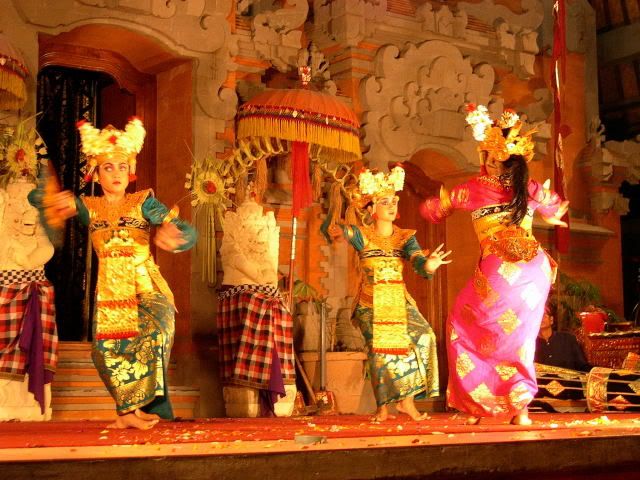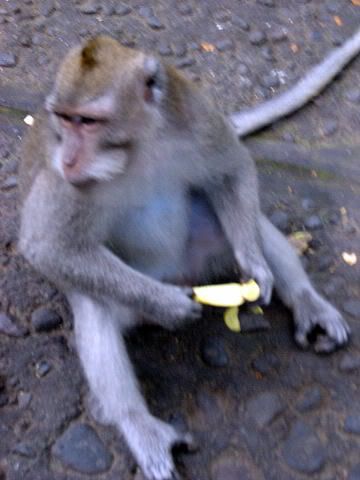 Ah, Ubud. Situated in the heart of Bali and reputed for ages as the artist and cultural center of Bali, then as a hippie haven, and now as a destination favored by many of the world’s elite celebs, it maintains its reputation as a glorious place to visit for those interested in a meld of art and spirituality.
Ah, Ubud. Situated in the heart of Bali and reputed for ages as the artist and cultural center of Bali, then as a hippie haven, and now as a destination favored by many of the world’s elite celebs, it maintains its reputation as a glorious place to visit for those interested in a meld of art and spirituality.How to get there: From Kuta/Legian/Denpasar, it is easy to commission a ride by van or bus at any of the small tourism kiosks around town. You will get a taste of Balinese driving, which may turn out to be the thrill of your life as you place that life in the hands of what may very well be a maniac while people and animals dart into the street like video-game challenges with a death-wish. You will then realize that Indonesian vehicles on the whole are only fitted with seat belts in the font seat and cling to anything that you can for dear life. But keep in mind that most drivers are gifted because they definitely don’t want to risk getting into an accident, lest an entire village descend upon them in a swarm of wrath akin to a scene from Hitchcock’s “Birds”.
Beautiful bungalows nestled against rice fields are available for a pittance and you can watch the ballet maneuvers of bats flutter about at dusk. Or are those just giant mosquitoes? 

You’ll want to check out the many galleries and craft hawkers that line just about any road in Ubud. You can negotiate prices in smaller shops and street stalls where the quality of art is less refined, but in the fine art galleries, don’t offend a master by trying this. Most importantly, you are supporting regional artists, which I recommend doing in all parts of the planet. The artists of this region are of particularly high caliber and reputation, but before you purchase anything sizable you best consider the expense and procedures required for bringing it home. Also be sure to get a receipt for customs officials.
Bali is also home to numerous quality museums. Exhibits typically have captions in English and Dutch in addition to Indonesian and possibly Balinese. Puri Lukisan is a delight to visit, not only for the quality of art within and the beginner’s lesson in Balinese art history, but the breathtaking gardens that surround it. You’ll think you’re in heaven. Museum Neka features the work of artists from Bali and Java as well as international artists who have spent time working from Bali and contributing to the artist culture. Museum Purbakala Gedong Area is devoted to research and houses antique art primarily. Angung Rai Museum of Art (ARMA) is a full service facility, complete with art, café, restaurant, performance areas and gamelan. For a comprehensive listing of museums and galleries in and around Ubud, try this link: http://www.indo.com/active/ubud3-1.html
Another place to view astonishing art is at a hindu temple. Temples generally welcome tourists with open arms, but please remember to have a little respect, for this is a place of worship, not Disneyland. Temples are used here, they are not only relics of the past. Some may charge a small entry fee to tourists and temple appropriate dress is required. Wear something tasteful, in other words. You may be asked to wear a sarong, which you may be given upon entry or you may want to buy one at a market in advance to avoid having to learn how to tie the thing in front of amused onlookers. The Elephant Temple or Goa Gajah is definitely one to visit, which is a mystery indeed with its gaping demonic-looking cave dedicated to Ganesa (Ganesh) and gorgeous surrounds.


Balinese dance, with its riot of beautiful colors and disciplined movements accompanied by the gamelan orchestra whose mysterious tones and rhythms at first sound particularly bizarre to western ears (but grows on you with time) can be admired at the place Puri Salen Agung. Consult the calendar of events for dates of particular types of dance which vary greatly.
For a good drink, try Murni’s Warung. All roads lead to Murni’s, in other words almost every taxi driver knows where it is. Owned by a wise woman, it is an astonishingly beautiful place to get trapped in a tropical downpour. Sip a Bintang beer or something slightly classier surrounded by native art and enjoy the open rainforest view complete with authentic sounds of simians and wild cats roaring if you’re as lucky as I was. You won’t want to leave. http://www.murnis.com/
There isn’t much in the way of partying in Ubud, but if you’re the intellectual type you’re going to love the selection of cafes to sit and pass the day in. A notable one is Café Tutmak, which I recently learned is owned by a local and his Berkley, California expat wife. Live music is common, as is discussion of Balinese culture.
There isn’t much in the way of partying in Ubud, but if you’re the intellectual type you’re going to love the selection of cafes to sit and pass the day in. A notable one is Café Tutmak, which I recently learned is owned by a local and his Berkley, California expat wife. Live music is common, as is discussion of Balinese culture.
For vegetarian food, there are many options. Of which I’m familiar with these: Eat for Health at Jalan Jembawa 5 which I’ve tried personally and highly recommend. They also have a number of herbal remedies on hand for whatever ails you. So Cool Vegetarian at Jalan Sugriwa 33 is, as the name implies, also strictly vegetarian. There are other places that are not strictly vegetarian or vegan but offer plenty of options. There is also a health food store, Andalan, at Jalan Jembawan 1. For a full listing check out: http://www.happycow.net/asia/indonesia/bali/index.html
A plethora of other activities are at hand in Ubud. Ayurvedic medicine and reflexology are widely practiced here thanks to the Indian influences introduced long ago. Take advantage of its studied practitioners, your body will thank you. Hiking, rafting, kayaking, and biking are also excellent ways to fully experience your surrounds. You can take organized tours by bike or rent at numerous shops.
 And then there’s the famed Mandala Wisata Wenara Wana or Monkey Forest as it is widely known. It is a sanctuary for the sacred macaques that populate it (approximately 300 of them, in fact) and hosts no less than three Hindu temples and gravesites. Entry tickets are 10,000RP which is roughly one US dollar. Outside women hawk bananas and peanuts to tourists who probably didn’t read the sign that says DON’T FEED THE MONKEYS. It is not highly recommended that you try feeding these guys unless you enjoy being accosted by wild and demanding furies. Again, I emphasize, these are not tame little zoo critters. They are wild and you should respect that. It is recommended that you secure all loose articles as the little buggers will steal sunglasses, water bottles and wallets alike.
And then there’s the famed Mandala Wisata Wenara Wana or Monkey Forest as it is widely known. It is a sanctuary for the sacred macaques that populate it (approximately 300 of them, in fact) and hosts no less than three Hindu temples and gravesites. Entry tickets are 10,000RP which is roughly one US dollar. Outside women hawk bananas and peanuts to tourists who probably didn’t read the sign that says DON’T FEED THE MONKEYS. It is not highly recommended that you try feeding these guys unless you enjoy being accosted by wild and demanding furies. Again, I emphasize, these are not tame little zoo critters. They are wild and you should respect that. It is recommended that you secure all loose articles as the little buggers will steal sunglasses, water bottles and wallets alike. 
One of the creepiest temples exists within the monkey forest, so you’ll have to brave those guys to enjoy it. Pura Dalem Agung is commonly refered to as the Temple of the Dead. When visiting the monkey forest temples, maintain the same manners that you would in any other Balinese temple. At Pura Dalem Agung, you will see some of the most violent and disturbing statues, which are mostly dedicated to the goddess Rangda, a demon queen who devours children just for kicks and with her legion of baddies, battles the good lion spirit Barong. She has claws, gaping maniacal eyes, and sagging breasts in most depictions. She is sometimes described as an incarnation of Durga or Kali. For an entertaining first hand encounter with the Monkey Forest and photos see: http://www.bentmachine.com/travel/bali/bali3.html
For more information on Ubud, peruse the following websites:
http://www.indo.com/active/ubud.html
http://www.balitravelportal.com/
http://goasia.about.com/library/weekly/aa032101a.htm
Next edition: Kintamani's relic graveyard, active volcanoes.
Recommended reading: I just discovered a book on punk and metal in Bali during the 90s which looks really interesting. I've included it in the Punk Rock Travel Store at Amazon.com which you'll find a link to at the right of my posts. It's called "Making Scenes: Reggae, Punk, and Death Metal in 1990s Bali" by Emma Baulk. If you've got questions about how counterculture spreads to remote locations and how it mutates to form new scenes, you might want to give it a read. I plan to. I've also filled my store with other books about Bali that I highly recommend.


No comments:
Post a Comment